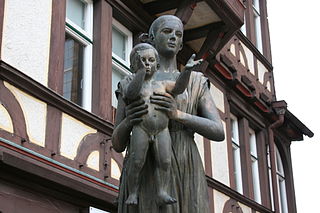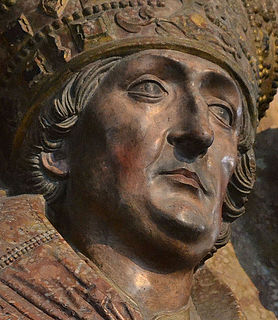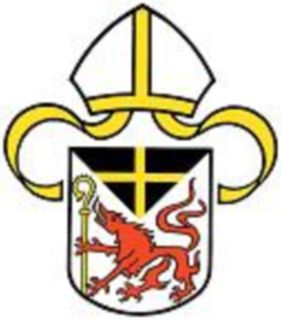Related Research Articles

Henry I of Hesse "the Child" was the first Landgrave of Hesse. He was the son of Henry II, Duke of Brabant and Sophie of Thuringia.

The Bishopric of Ösel–Wiek was a Roman Catholic diocese and semi-independent prince-bishopric in the Holy Roman Empire, covering what are now Saare, Hiiu and Lääne counties of Estonia.

The Prince-Bishopric of Würzburg was an ecclesiastical principality of the Holy Roman Empire located in Lower Franconia west of the Prince-Bishopric of Bamberg. Würzburg had been a diocese since 743. As definitely established by the Concordat of 1448, bishops in Germany were chosen by the canons of the cathedral chapter and their election was later confirmed by the pope. Following a common practice in Germany, the prince-bishops of Würzburg were frequently elected to other ecclesiastical principalities as well. The last few prince-bishops resided at the Würzburg Residence, which is one of the grandest baroque palaces in Europe.

The Diocese of Lavant(tal) was a suffragan bishopric of the Archdiocese of Salzburg, established 1228 in the Lavant Valley of Carinthia.

Lorenz von Bibra, Duke in Franconia was Prince-Bishop of the Bishopric of Würzburg from 1495 to 1519. His life paralleled that of Maximilian I (1459–1519), who served as Holy Roman Emperor from 1493 to 1519, whom Lorenz served as an advisor.

The Prince-Bishopric of Bamberg was an ecclesiastical State of the Holy Roman Empire. It goes back to the Roman Catholic Diocese of Bamberg established at the 1007 synod in Frankfurt, at the behest of King Henry II to further expand the spread of Christianity in the Franconian lands. The bishops obtained the status of Imperial immediacy about 1245 and ruled their estates as Prince-bishops until they were subsumed to the Electorate of Bavaria in the course of the German Mediatisation in 1802.

The Niedermünster or Niedermünster Abbey, Regensburg, was a house of canonesses (Frauenstift) in Regensburg, Bavaria, Germany. At the height of its power it was one of the wealthiest and most influential in Bavaria. The church is still in use as the parish church of Regensburg Cathedral.

The Prince-Bishopric of Paderborn was an ecclesiastical principality (Hochstift) of the Holy Roman Empire from 1281 to 1802.

Otto II, Duke of Brunswick and Lüneburg, also known as Otto the Strict, came from the House of Welf and was Prince of Lüneburg from 1277 to 1330.
The Bavarian War from 1420 to 1422, also known as the Great War of the Lords, was a conflict between Louis VII the Bearded of Bayern-Ingolstadt and Henry XVI of Bavaria-Landshut. The conflict overshadowed Louis VII's reign, which lasted more than thirty years.
Christoph von Stadion (1478–1543) was Prince-Bishop of Augsburg from 1517 to 1543.

Rottenegg is a village in the Hallertau of Bavaria, Germany. Formerly a separate municipality, it is now part of the municipality of Geisenfeld in the Upper Bavarian district of Pfaffenhofen.
Barbara von Absberg was abbess of Obermünster in Regensburg from 1435 to 1456.

Gottfried von Passau also Gottfried I was the 41st bishop of Passau from 1283 to 1285.
References
Citations
- ↑ Wendehorst 2006, p. 124.
- 1 2 Freilinger 1977, p. 243, 274.
- 1 2 3 Der Domschatz und seine Geschichte: Bistumsmuseen.
- 1 2 Lipowsky 1811, p. 121.
- ↑ Bischof Gottfried (1282/83–1285).
- ↑ McLachlan 2004, p. 141.
- ↑ Hourihane 2012, p. 424.
Sources
- "Bischof Gottfried (1282/83–1285)" . Retrieved 2014-01-03.
- "Der Domschatz und seine Geschichte". Bistumsmuseen Regensburg. Retrieved 2014-01-03.
- Freilinger, Hubert (1977). Historischer Atlas von Bayern. 46. Kommission für bayerische Landesgeschichte.
- Hourihane, Colum (2012-12-06). The Grove Encyclopedia of Medieval Art and Architecture. Oxford University Press. ISBN 978-0-19-539536-5 . Retrieved 2014-01-03.
- Lipowsky, Felix Joseph (1811). "Heinrich von Rotteneck〉; -1296; 1277-1296 Bischof von Regensburg (PND 120677822)". Baierisches Musik-Lexikon. Munich. Retrieved 2014-01-03.
- McLachlan, Gordon (2004). The Rough Guide to Germany . Rough Guides. p. 141. ISBN 978-1-84353-293-4 . Retrieved 2014-01-03.
- Wendehorst, Alfred (2006). Das Bistum Eichstätt: Die Bischofsreihe bis 1535. 1. Berlin: Walter de Gruyter. ISBN 978-3-11-018971-1 . Retrieved 2014-01-03.